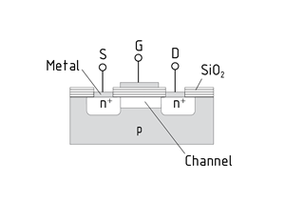
Choose one
or multiple languages
0,1,1
- German
- English
- Chinese
- Spanish
MOSFET

A MOSFET (Metal-Oxide Semiconductor Field-Effect Transistor) is a voltage-controlled component in semi-Conductor technology. Due to its compact Design and because numerous MOSFETs can be implemented on one IC, it is often used in integrated circuits. MOSFETs are also utilised in Power electronics at high frequencies.
MOSFETs benefit from powerless control in a static state. Applying a gate voltage forms a conducting channel between the source and drain connections. Due to the oxide layer on the gate electrode, there is no current flowing at the gate. This results in powerless control of the MOSFET. The charge-reversal currents required due to the capacitances present in the dynamic state result in control losses.
Leakage currents are one drawback of MOSFETs. These unwanted current flows within the component are always present because of the design and are responsible for up to 50 percent of the entire energy consumption.
In terms of practical application, it is important to bear in mind that MOSFETs are highly sensitive to electrostatic discharge. If they are not handled properly, the gate insulating layer can be destroyed.
